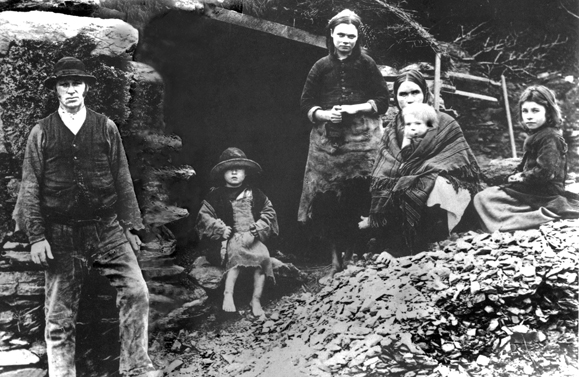An Gorta Mór (The Great Hunger)

The Great Hunger, as most historians now call it, struck again in Ireland between 1845 and 1852 with devastating consequences for Ireland and it's inhabitants. Derry quay became the 2nd largest port for emigration in Ireland in the years 1845-52 as around 2 million people left Ireland’s shores never to return. Why did 1.5 million Irish die in Ireland when only the potato crop had been blighted and failed? What were the consequences for Ireland and the Irish?
Although potato blight was not uncommon in Ireland in the 19th century it is the recurrence of the blight for 7 or more seasons that leads to the total failure of the Lumper potato crop in Ireland. The blight that struck in Ireland was of course a natural occurrence but it would be the British government’s reaction or inaction that would cause the deaths of so many. The policy of ‘laissez-faire’ taken by the British was a sign of how the Irish were viewed by the middle-upper classes of the British establishment of the time. The native Irish Catholics were seen by some as subhuman lazy drunkards who were not worth saving. Non-interference by the British is of course not strictly true. During the years of the potato blight Ireland produced enough grain crops to easily feed the population. Any food that was grown in Ireland like grain crops, pork, beef, lamb and vegetables, even during the worst years, were exported out of Ireland to England with 200,000 British troops guarding the ports to make sure that the food made it out unhindered. All this done while 1.5 million native Irish starved. The lucky ones made it to the ‘Coffin Ships’.
Emigration in Ireland reached 2 million during the Great Hunger as the landlords used the hunger to clear the land of tenant farmers and make way for the more profitable sheep farming. People flocked to the cities in a bid to find employment or food in these desperate times leaving the more rural areas of Ireland almost completely empty of inhabitants. The Irish language, which was strongest in the rural areas, was also dealt a devastating blow. If employment was not found then it was the Coffin Ships that people would end up on travelling to the United States or Australia. As most of these ships were designed to carry commodities other than people the ships were ill prepared for human travel and a good percentage of the human cargo would not make it to the other side either through gross negligence and profiteering by the ship owners or through weakness from hunger and disease. Although there were some ship owner who did try and make the ships habitable for humans most were simply in for the profit and send people as cheaply as possible not caring if they lived or died.
The Great Hunger is still etched in almost every Irish mindset especially when it comes to food and food waste. The Lumpier potato was dropped from the Irish dinner table as it was seen as being
jinxed. It is only in the last few years that the Lumper has started to make a come back. Ireland still has not recovered in number terms since the potato blight with numbers in 1840 reaching
over the 8 million mark. The Irish are known world wide for their generosity and especially when it comes to countries devastated by war and hunger donating more per head than most other
countries. Derry and indeed Ireland has played it’s part in trying to alleviate the distress caused by this totally avoidable disaster but it has also lead to the Irish being aware of and be one
of the first to donate to other countries knowing only too well what it’s like for others to stand idly by.
